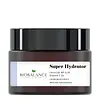What's inside
What's inside
 Key Ingredients
Key Ingredients

 Benefits
Benefits

 Concerns
Concerns

 Ingredients Side-by-side
Ingredients Side-by-side

Water
Skin ConditioningGlycerin
HumectantCaprylic/Capric Triglyceride
MaskingCoco-Caprylate/Caprate
EmollientGlyceryl Stearate
EmollientButylene Glycol
HumectantCetearyl Alcohol
EmollientPolyglyceryl-6 Palmitate/Succinate
EmulsifyingCeramide NP
Skin ConditioningLinoleic Acid
CleansingLinolenic Acid
CleansingAcacia Senegal Gum
MaskingXanthan Gum
EmulsifyingTocopherol
AntioxidantTetrasodium Glutamate Diacetate
Sorbitan Caprylate
EmulsifyingPropanediol
SolventBenzoic Acid
MaskingWater, Glycerin, Caprylic/Capric Triglyceride, Coco-Caprylate/Caprate, Glyceryl Stearate, Butylene Glycol, Cetearyl Alcohol, Polyglyceryl-6 Palmitate/Succinate, Ceramide NP, Linoleic Acid, Linolenic Acid, Acacia Senegal Gum, Xanthan Gum, Tocopherol, Tetrasodium Glutamate Diacetate, Sorbitan Caprylate, Propanediol, Benzoic Acid
Water
Skin ConditioningGlycerin
HumectantCetearyl Alcohol
EmollientCaprylic/Capric Triglyceride
MaskingGlyceryl Stearate
EmollientC12-15 Alkyl Benzoate
AntimicrobialNiacinamide
SmoothingSqualane
EmollientBakuchiol
AntimicrobialAcacia Senegal Gum
MaskingHyaluronic Acid
HumectantHydrolyzed Hyaluronic Acid
HumectantPanax Ginseng Root Extract
EmollientEchinacea Angustifolia Root Extract
Skin ConditioningHypericum Perforatum Extract
AntimicrobialSodium Hyaluronate
HumectantEquisetum Arvense Leaf Extract
AstringentDaucus Carota Sativa Root Extract
Skin ConditioningAesculus Hippocastanum Seed Extract
Skin ConditioningSodium Hydroxide
BufferingSodium PCA
HumectantPanthenol
Skin ConditioningSodium Hyaluronate Crosspolymer
HumectantHydrolyzed Glycosaminoglycans
HumectantCeteareth-20
CleansingCeteareth-12
EmulsifyingCetyl Palmitate
EmollientPotassium Cetyl Phosphate
EmulsifyingAcrylates/C10-30 Alkyl Acrylate Crosspolymer
Emulsion StabilisingTocopheryl Acetate
AntioxidantPropanediol
SolventPropylene Glycol
HumectantSodium Benzoate
MaskingPalmitoyl Tetrapeptide-7
Skin ConditioningPentylene Glycol
Skin ConditioningN-Prolyl Palmitoyl Tripeptide-56 Acetate
Skin ConditioningPolysorbate 20
EmulsifyingPalmitoyl Tripeptide-1
Skin ConditioningPotassium Sorbate
PreservativeBenzyl Alcohol
PerfumingButylene Glycol
HumectantCarbomer
Emulsion StabilisingCaprylyl Glycol
EmollientTetrasodium EDTA
Phenoxyethanol
PreservativeEthylhexylglycerin
Skin ConditioningWater, Glycerin, Cetearyl Alcohol, Caprylic/Capric Triglyceride, Glyceryl Stearate, C12-15 Alkyl Benzoate, Niacinamide, Squalane, Bakuchiol, Acacia Senegal Gum, Hyaluronic Acid, Hydrolyzed Hyaluronic Acid, Panax Ginseng Root Extract, Echinacea Angustifolia Root Extract, Hypericum Perforatum Extract, Sodium Hyaluronate, Equisetum Arvense Leaf Extract, Daucus Carota Sativa Root Extract, Aesculus Hippocastanum Seed Extract, Sodium Hydroxide, Sodium PCA, Panthenol, Sodium Hyaluronate Crosspolymer, Hydrolyzed Glycosaminoglycans, Ceteareth-20, Ceteareth-12, Cetyl Palmitate, Potassium Cetyl Phosphate, Acrylates/C10-30 Alkyl Acrylate Crosspolymer, Tocopheryl Acetate, Propanediol, Propylene Glycol, Sodium Benzoate, Palmitoyl Tetrapeptide-7, Pentylene Glycol, N-Prolyl Palmitoyl Tripeptide-56 Acetate, Polysorbate 20, Palmitoyl Tripeptide-1, Potassium Sorbate, Benzyl Alcohol, Butylene Glycol, Carbomer, Caprylyl Glycol, Tetrasodium EDTA, Phenoxyethanol, Ethylhexylglycerin
 Reviews
Reviews

Ingredients Explained
These ingredients are found in both products.
Ingredients higher up in an ingredient list are typically present in a larger amount.
Acacia Senegal Gum has skin soothing, thickening, and formulation stabilizing properties. It comes from the Acacia tree that is native to sub-Saharan Africa.
Butylene Glycol (or BG) is used within cosmetic products for a few different reasons:
Overall, Butylene Glycol is a safe and well-rounded ingredient that works well with other ingredients.
Though this ingredient works well with most skin types, some people with sensitive skin may experience a reaction such as allergic rashes, closed comedones, or itchiness.
Learn more about Butylene GlycolThis ingredient is an emollient, solvent, and texture enhancer. It is considered a skin-softener by helping the skin prevent moisture loss.
It helps thicken a product's formula and makes it easier to spread by dissolving clumping compounds.
Caprylic Triglyceride is made by combining glycerin with coconut oil, forming a clear liquid.
While there is an assumption Caprylic Triglyceride can clog pores due to it being derived from coconut oil, there is no research supporting this.
Learn more about Caprylic/Capric TriglycerideCetearyl alcohol is a mixture of two fatty alcohols: cetyl alcohol and stearyl alcohol. It is mainly used as an emulsifier. Emulsifiers help prevent the separation of oils and products. Due to its composition, it can also be used to thicken a product or help create foam.
Cetearyl alcohol is an emollient. Emollients help soothe and hydrate the skin by trapping moisture.
Studies show Cetearyl alcohol is non-toxic and non-irritating. The FDA allows products labeled "alcohol-free" to have fatty alcohols.
This ingredient is usually derived from plant oils such as palm, vegetable, or coconut oils. There is debate on whether this ingredient will cause acne.
Due to the fatty acid base, this ingredient may not be Malassezia folliculitis safe.
Learn more about Cetearyl AlcoholGlycerin is already naturally found in your skin. It helps moisturize and protect your skin.
A study from 2016 found glycerin to be more effective as a humectant than AHAs and hyaluronic acid.
As a humectant, it helps the skin stay hydrated by pulling moisture to your skin. The low molecular weight of glycerin allows it to pull moisture into the deeper layers of your skin.
Hydrated skin improves your skin barrier; Your skin barrier helps protect against irritants and bacteria.
Glycerin has also been found to have antimicrobial and antiviral properties. Due to these properties, glycerin is often used in wound and burn treatments.
In cosmetics, glycerin is usually derived from plants such as soybean or palm. However, it can also be sourced from animals, such as tallow or animal fat.
This ingredient is organic, colorless, odorless, and non-toxic.
Glycerin is the name for this ingredient in American English. British English uses Glycerol/Glycerine.
Learn more about GlycerinGlyceryl Stearate is a mix of glycerin and stearic acid.
It is used to stabilize the mixing of water and oil ingredients. By preventing these ingredients from separating, it can help elongate shelf life. It can also help thicken the product's texture.
As an emollient, it helps soften skin and supports barrier-replenishing ingredients.
In cosmetics, Glyceryl Stearate is often made from vegetable oils or synthetically produced.
This ingredient may not be fungal-acne safe
Fun fact: The human body also creates Glyceryl Stearate naturally.
Learn more about Glyceryl StearatePropanediol is an all-star ingredient. It softens, hydrates, and smooths the skin.
It’s often used to:
Propanediol is not likely to cause sensitivity and considered safe to use. It is derived from corn or petroleum with a clear color and no scent.
Learn more about PropanediolWater. It's the most common cosmetic ingredient of all. You'll usually see it at the top of ingredient lists, meaning that it makes up the largest part of the product.
So why is it so popular? Water most often acts as a solvent - this means that it helps dissolve other ingredients into the formulation.
You'll also recognize water as that liquid we all need to stay alive. If you see this, drink a glass of water. Stay hydrated!
Learn more about Water